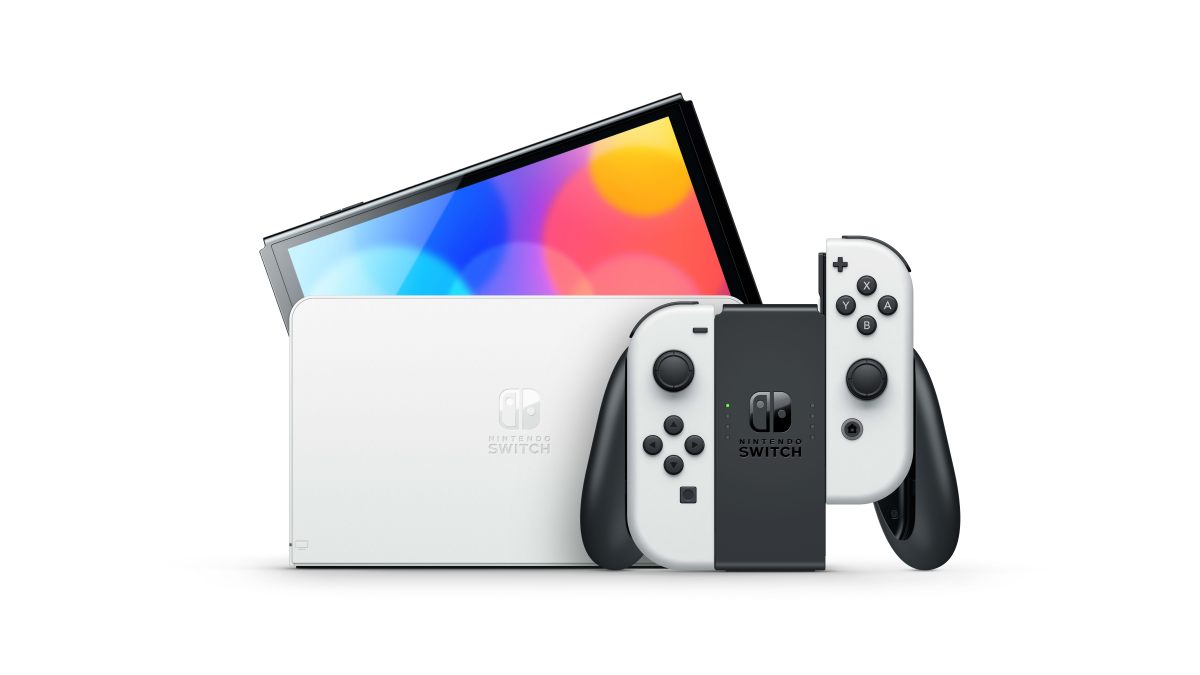It has become the norm to see the release of hardware revisions of mainline gaming consoles – and if there’s a company that’s well-accustomed to such a practice, it’s Nintendo. Nintendo’s long history of releasing improved hardware during console life cycles began with their first home gaming system, the NES, with the Japanese Famicom receiving a heavy facelift when it hit Western shelves in 1985. Some folk will also remember the beloved Gameboy getting the cutesy and colourful Pocket treatment, and let’s not forget about the DS family of systems, too. From the very beginning, almost every Nintendo console has in some way or another had hardware refinements, and the Nintendo Switch is no different. Come the 8th of October this year, the Nintendo Switch (OLED) model will be in consumers’ hands and, although it’s not the heavily rumoured ‘Switch Pro’ that people may have hoped for, it is home to some welcome improvements that will enrich players’ experiences, especially for those who play predominantly in handheld mode.
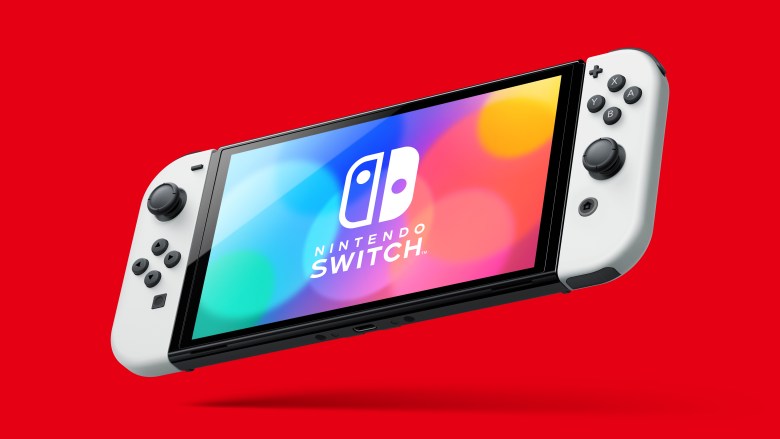
Settling down in a hotel in London, Nintendo presented us with a short but informative slideshow, highlighting the key features the OLED model boasts compared to its original counterpart. We were then able to fully explore the Nintendo Switch (OLED) model in this one-hour session, fiddle with its new dock and test some evergreen first-party titles, such as Mario Kart 8 Deluxe and The Legend of Zelda: Breath of the Wild. We did ask for a sneak peek at Metroid Dread but no such luck, unfortunately.
On the retail front, the OLED model comes in two variations: the white Joy-Con set and the Neon Red and Blue Joy-Con set. Packaged vertically to “stand out on store shelves”, according to the Nintendo rep, each pack are sold at the same price ($350/£309.99 RRP) and both come with the same improved white dock — we’ll get to why it’s a step-up from the original dock later on. It’s worth remembering that the tech inside the Joy-Con is the same as the ones we have now. When we asked about the prospect of the white Joy-Con being made available to buy separately, we were told they’ll only be available with the OLED model, but the white dock will be made available to purchase on its own from the Nintendo store.

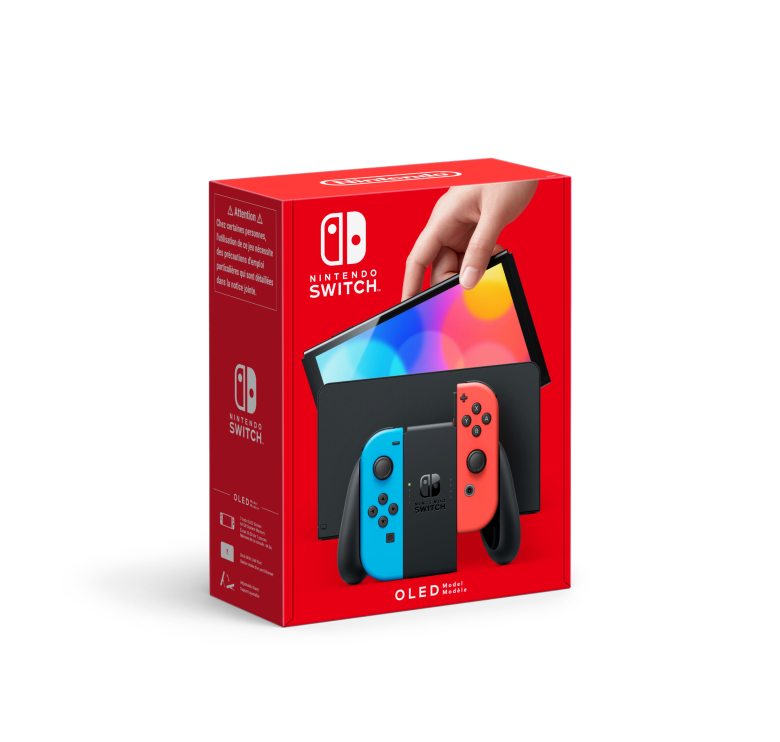
It’s easy to see how pre-orders were snapped up so quickly. It’s a gorgeous console – even from the packaging – and more so when it’s nestled in your hands. The screen size has been increased to an impressive and very noticeable 7 inches, something which is hard to gauge from pictures alone. While comparing this to the 6.2 inch LED screen of the original side-by-side, it’s remarkable just what a difference it makes. We fired up a game of Mario Kart 8 Deluxe and headed into some local multiplayer with a journalist from Eurogamer. After *ahem* winning every race, the main takeaway from each round was just how bright and vibrant the colours popped. As we drifted around Yoshi’s Circuit and blasted our way around the twists and turns of Ribbon Road, every detail seemed sharper and more refined. Of course, the OLED model doesn’t have a more powerful chipset (it’s the same custom NVIDIA Tegra X1), but the display made a considerable difference.
The same applied for The Legend of Zelda: Breath of The Wild. Waking Link up after his 100-year slumber and stumbling to the famous cliff edge, the opening 10 minutes of the esteemed open-world adventure burst with colour; the Great Plateau looked even more incredible, and we had to actually turn the brightness down as it was almost too dazzling. It’s worth noting here that we turned off the auto-brightness completely for testing purposes, but the feature remains and reacts as quickly as it does with the current model. We decided to tilt the screen so the lighting in the room was refracting off the Switch’s display, and our view of the action was hardly altered. This could be a huge benefit for gamers out there who want to tackle their favourite titles outdoors, since the original LED screen tends to struggle when it’s exposed to direct sunlight. It’s also benefited by a thin bezel that does a great job of amplifying the larger screen. Make no mistake though, the OLED display is the star of the show.
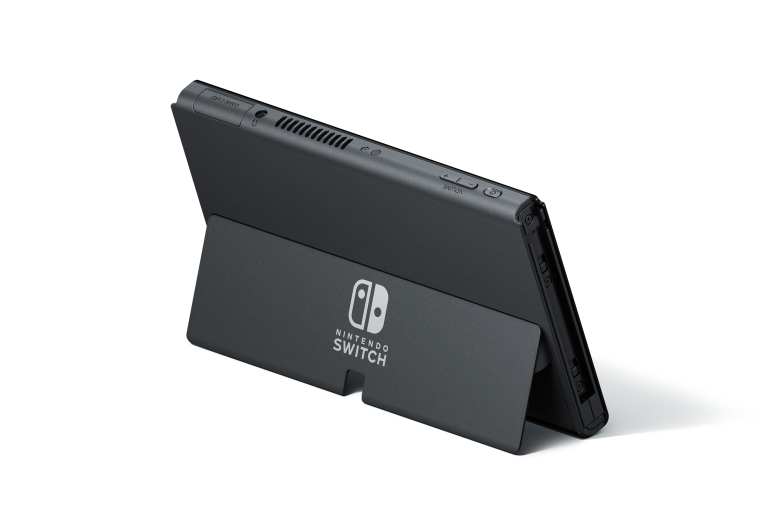
Another gripe that some have with the current console is its small stand. Admittedly, the rather tiny and flimsy stand serves its purpose, nevertheless the lack of adjustment means that you’re restricted with just one viewing angle. So, when we carefully flipped the OLED model over and pulled out the sturdy and almost fully adjustable stand to jump into Mario Odyssey, it felt refreshing to have the option to alter the angle in a way we actually wanted. The console can virtually rest completely flat with it fully kicked out. Again, this is a feature that will help convince those who play in tabletop mode to upgrade, yet we don’t envisage this necessarily swaying TV mode players to, dare we say it, make the switch.
Although minuscule, we’re told that the OLED model weighs in at just above the original counterpart. It’s only by a fraction and it’s not particularly noticeable. The stereo speakers, however, deserve a small mention as audio came across slightly crisper, especially in Breath of the Wild. Nintendo stated that the on-board speakers have been improved and, cranking up the volume fully, we were inclined to agree. But for the most part we couldn’t pick up much of an improvement, apart from how loud the action was able to get.
As mentioned previously, the next member of the Switch family comes with a new and improved dock. The first thing we immediately noticed (apart from its beautiful, sleek white colour) was how much more sturdy it felt compared to the original dock. It also felt a little heavier, too. Its rounded edges, matte finish and shiny interior gives a much more premium feel and look – it will complement your shelving unit, that’s for sure. The bottom of the dock has a different material that helps to keep it in place and, after gripping the new dock, it held steadfast in place when we tried to shift it, which will be a perk for those who have wandering toddler hands in their households! Instead of a hinged door, the back of the dock comes clean off. It’s easily put back in place with a satisfying click. Nintendo have opted to remove the USB port behind the flap at the back and have replaced it with a built-in LAN port, which promises to cut down lag when in TV mode. Fans of games such as Super Smash Bros. Ultimate will reap the benefits of this, along with more competitive players who rely on a stable internet connection.
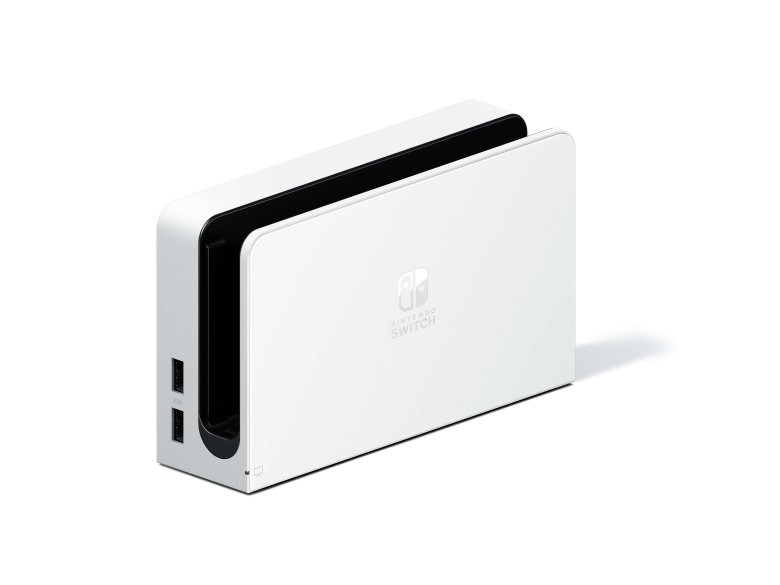
At the preview event, we didn’t see the OLED model perform while in docked mode, yet we were reminded on a few occasions that the innards of the console are no different to the ver1.1 Nintendo Switch model — that’s the one with the improved battery life readily available today. In terms of onboard memory, the OLED Switch comes with an expandable 64GB memory capacity compared to the expandable 32GB of memory for the original Nintendo Switch and Switch Lite. However, we did notice while experimenting with the adjustable stand that the memory card slot is much easier to access and isn’t half as fiddly.
It’s clear that the Nintendo Switch (OLED) model is geared towards consumers who play mostly in handheld mode. TV-mode lovers may not feel the true value here but, then again, it could well sway their preferred habits thanks to its improvements. For instance, with the clearer display you may want to re-experience some of your favourite games in handheld mode. And when docking the OLED model, you won’t be able to tell the difference from your original console , bar from the lovely white dock sitting beneath the television. However, the sensational OLED display, nearly non-existent bezel and louder speakers certainly left an impression on us. This updated Switch model will absolutely let you play anywhere, anytime and with anyone more comfortably. In its own right that could be enough to draw not only a new fanbase, but tempt existing Switch players to part with their cash once again.
A one-hour hands-on session with the Nintendo Switch (OLED) model was provided by Nintendo UK.
Related
My Nintendo News
Source link
Related Post:
- Nintendo Switch OLED Model Vs. Standard Switch / Switch Lite: Full Tech Specs Comparison
- Nintendo Will Not Release A New Model After OLED Nintendo Switch
- Nintendo denies Bloomberg article claiming Nintendo Switch (OLED model) has higher profit margins
- Nintendo comments on screen burn for Nintendo Switch (OLED) model, says they have aimed for “longevity”
- The NEW Nintendo Switch OLED Model Just Feels Off…
- Nintendo unveils new Switch OLED model
- Nintendo Announces Switch OLED Model Releasing October 8th
- Nintendo Switch OLED Model Announced
- No new model planned for Switch as Nintendo denies OLED margin increase
- Nintendo Switch OLED Model Announced; Features 7-Inch Screen, LAN Port, and More
